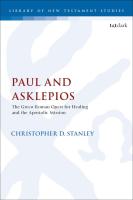
T. & T. Clark (2023) h/b 253pp £90 (ISBN 9780567696557)
This detailed study attempts to answer the question of what part the quest for healing is likely to have played in the spread of early Christianity and especially in the mission of St Paul. The Acts of the Apostles contain a number of examples of cures attributed to Peter and other apostles including Paul, yet, curiously, Paul makes no mention of them in his letters; he refers to the many injuries and ailments he himself has suffered from as well as the serious illness of Epaphroditus, but says nothing about taking action to seek a cure. To get an idea of what Paul’s attitude to healthcare may have been, the only option is to set him in context and examine what we do know about what people in the Greek and Roman world of the 1st and 2nd C AD thought and did about healthcare. It turns out that there is quite a lot of evidence, which is set out with great thoroughness.
A key point is that we have to shed our 21st century bias arising from the elaborate science-based healthcare systems we have now. In those days, even those who attributed illnesses to natural causes did not rule out the involvement of the gods and the need to have recourse to them. Three broad classifications are described: home remedies and ‘magical’ treatments such as amulets, incantations, divination, exorcism, special herbs etc. ‘religious’ treatments, especially recourse to Asklepios, who had a temple in every major city, in the hope of getting healing instructions in a dream; and ‘medical’ treatments based on repeated evidence of what worked as prescribed by followers of Hippocrates and others.
Those three categories are discussed in relation to a) the general Greek and Roman population, b) Judaeans and c) early Christians. The evidence appears to be that there was no practical difference between these groups—they all continued to use all three approaches, according to what they were used to and thought would work, and could afford. Christian church leaders, for example, tried very hard to turn their flocks away from magical and old religious practices, recasting the pagan gods as demons, but it took a long time (several centuries) for customs to change, especially among rural and less educated populations. As late as the fifth century, it seems, Christians were still visiting Asklepian healing centres and using `magical’ practices, even when they were condemned by the church authorities.
After his very full account of the evidence, S. returns to Paul’s silence on the matter and considers various hypotheses about what he might have thought. His preferred explanation is that Paul practised a variety of healing methods but had no reason to discuss them in his letters: in his view, by whatever route the healing comes, it is according only to God’s (Christ’s) will, and no other deity is involved; so long as one is convinced of that, no harm is done. Paul’s ruling on the eating of sacrificial meat is analogous: the ‘deities’ to which the sacrifice had been made are not real and not worshipped, so it is no different from any other ordinary meat and a Christian can eat it with impunity. So long as his converts avoided rituals which explicitly worshipped other gods, Paul saw no reason for them to change their habits.
This book is packed with detail drawn from many different sources (and which has spawned a large bibliography), and at the same time wrestles with alternative explanations all of which are made highly speculative by lack of clear evidence. All this makes it a testing read, but an interesting one.
Colin McDonald
